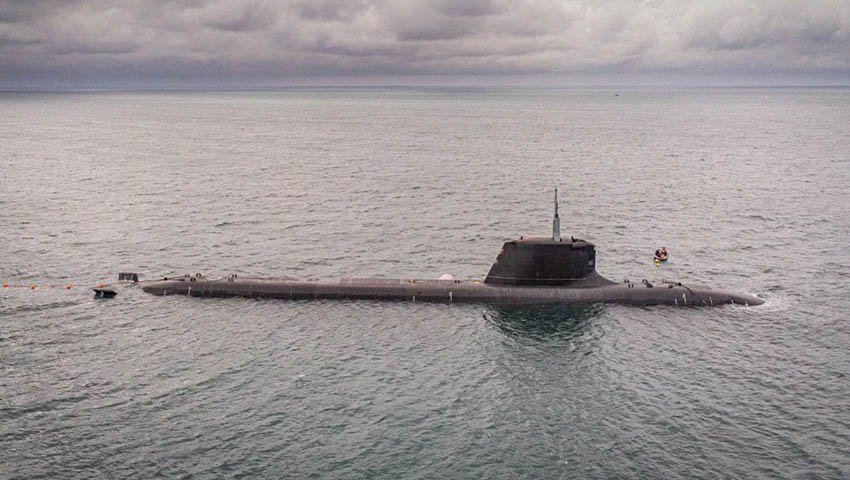
Suffren, the first of six Barracuda-class nuclear-powered attack submarines being built for the French Navy, has kicked off her sea trials with her first dive at sea. These trials were originally due to begin in early 2020
Led by the French Armaments Directorate (DGA), these sea trials, which will last several months, will confirm the robustness and efficiency of the submarine before her hand-over to the French Navy.
At dockside as at sea, the test campaign will follow the specific health prevention and precautionary measures linked to the COVID-19 pandemic.
The SSNs are real instruments of power, enduring and discreet. Their missions are varied, and range from support to the deterrent force, protection of the carrier strike group, intelligence gathering, and anti-submarine and anti-ship warfare. Suffren-type SSNs will add a land-attack cruise missile capability and will be optimized for the deployment of special forces.
With the Suffren, France is starting to renew its fleet of SSNs, which entered service in the 1980s, and will thus have modern submarines among the most efficient in the world.
With this first outing at sea, the Barracuda program crosses a major milestone after the launch of Suffren, on July 12, 2019, by the President of the Republic.
Over the past eight months, the program’s industrial and state teams have successfully conducted all of the Suffren’s dockside tests aimed at verifying the proper functioning of its various systems and equipment. Three prerequisites have been validated: the combat system has reached the end of its tests on land and is ready for the continuation of assessments at sea; the nuclear reactor was started at the end of 2019 after loading its fuel and, finally, in January 2020 the submarine was floated to validate the first waterproofness tests.
Started in the English Channel, these sea trials will later take the Suffren to the Atlantic and finally to the Mediterranean. Under the supervision of engineers and technicians from the DGA, the French Atomic Energy and Alternative Energies Commission (CEA), Naval Group and TechnicAtome, they will be carried out by submariners of the French Navy who will gradually check all of the boat’s technical and operational capabilities.
They are due to last several months until her delivery scheduled for later this year. During the entire phase of sea trials, the boat remains the property of Naval Group. She is placed under the responsibility of the French Navy for operational command and as a delegated nuclear operator. As the contracting authority for the Barracuda program, the DGA is responsible for testing up to the acceptance of the boat and her delivery to the French Navy.
The DGA worked with the CEA, the French Navy and industrial prime contractors to allow the program to continue under specific health conditions. Since March 16, the business continuity plan for the Cherbourg site and the Barracuda program takes into account all measures to ensure the health and safety of personnel.
Barracuda class (also called Suffren class after the lead ship of the class) is a class of nuclear-powered attack submarines (SSNs; French: Sous-marins nucléaires d’attaque, SNA) being developed for the French Navy.
Launched in 1998 by the French Defence Procurement Agency (DGA), the Barracuda program renews the Navy’s SSN component currently composed of six Rubis class SSNs commissioned from the early 1980s. The associated development contract was notified in December 2006.
Naval Group is the overall prime contractor of the submarine program and TechnicAtome is the prime contractor for the nuclear reactor. The French Defence Procurement Agency ( Direction générale de l’armement, DGA) is in charge of the overall program, with the Atomic Energy and Alternative Energies Commission (Commissariat à l’énergie atomique et aux énergies alternatives, CEA) for the nuclear reactor.
Barracuda SSNs will use technologies from the French Navy’s currently operational Triomphant-class nuclear-powered ballistic missile submarines (SSBNs), including pump-jet propulsion.
The submarines will have a length of 99 meters, a diameter of 8.8 meters, a surfaced displacement of 4,700 tonnes and an underwater displacement of 5,300 tonnes.
The boats will be powered by a 50MW K15 pressurized water reactor derived from the reactors on board the Triomphant-class SSBNs and Charles-de-Gaulle aircraft carrier. They will have two propulsion turbines, two turbo generators and two electric motors driving a single ducted propeller (pump-jet). The SSNs will have a maximum speed of about 25 knots and a maximum diving depth of more than 350 m.
The Barracuda-class submarines will be armed with torpedo-tube-launched cruise missile, MdCN (Missile de Croisière Naval, Naval Cruise Missile). MdCN is the sea-launched variant of the SCALP EG low-observable air-launched cruise missile (ALCM) developed by MBDA Missile Systems. The missile has an operational range of over 1,000 km (620 mi) and can be fired against strategic land targets.
The submarines will be also armed with F21 Artemis heavyweight torpedoes, Exocet SM39 Block2 anti-ship missiles and FG29 mines.
Barracudas will have a crew complement of 65. In support of special operations missions, they may also accommodate up to 12 commandos, while carrying their equipment in a dry deck shelter attached aft of the sail. The dry deck shelter will also allow the deployment of underwater vehicles.
The primary missions of the Barracuda-class vessels will include anti-surface and anti-submarine warfare (ASuW, ASW), land attack, intelligence gathering, crisis management and special operations missions.
The French Navy plans to have six SNA Barracuda in service by 2030 and the first four is scheduled to be delivered over the period of 2020-2025. Considering that the lifespan of Suffren type SSNs will be more than 35 years, these new submarines will serve the French Navy at least up to 2060, making it one of the major French weapon systems of this century.